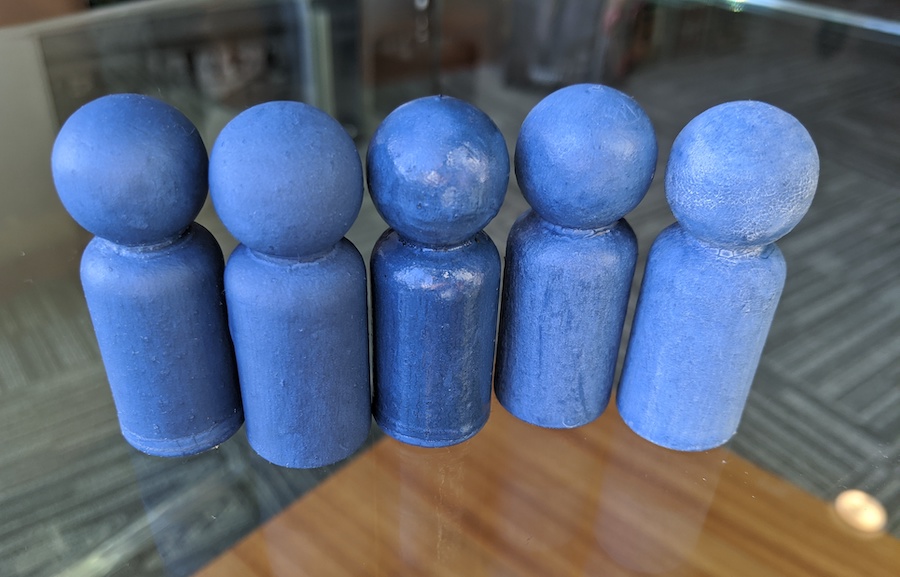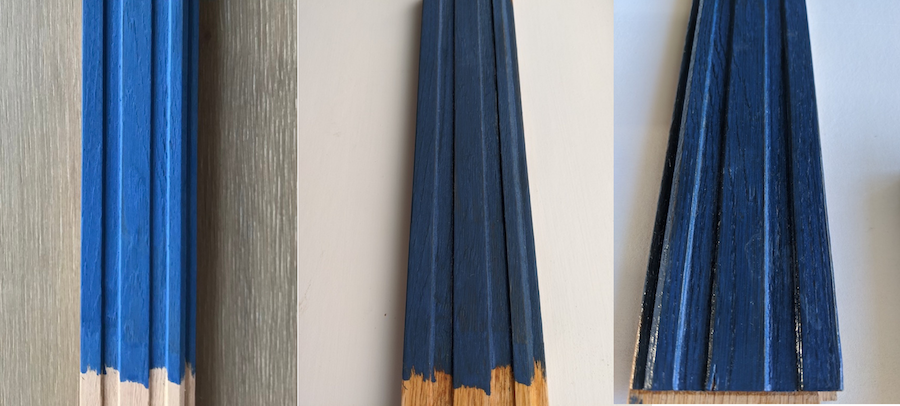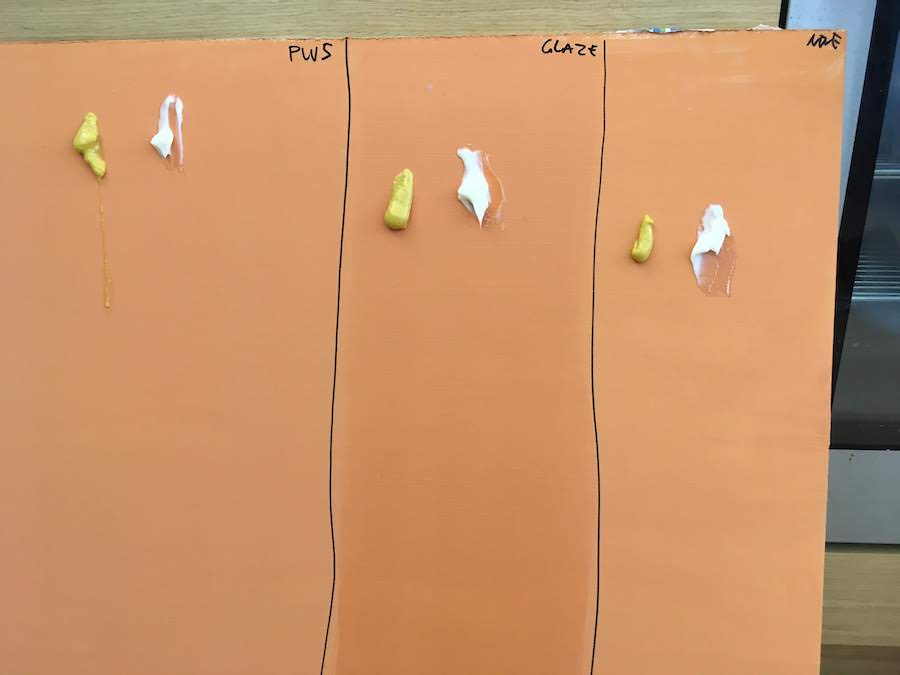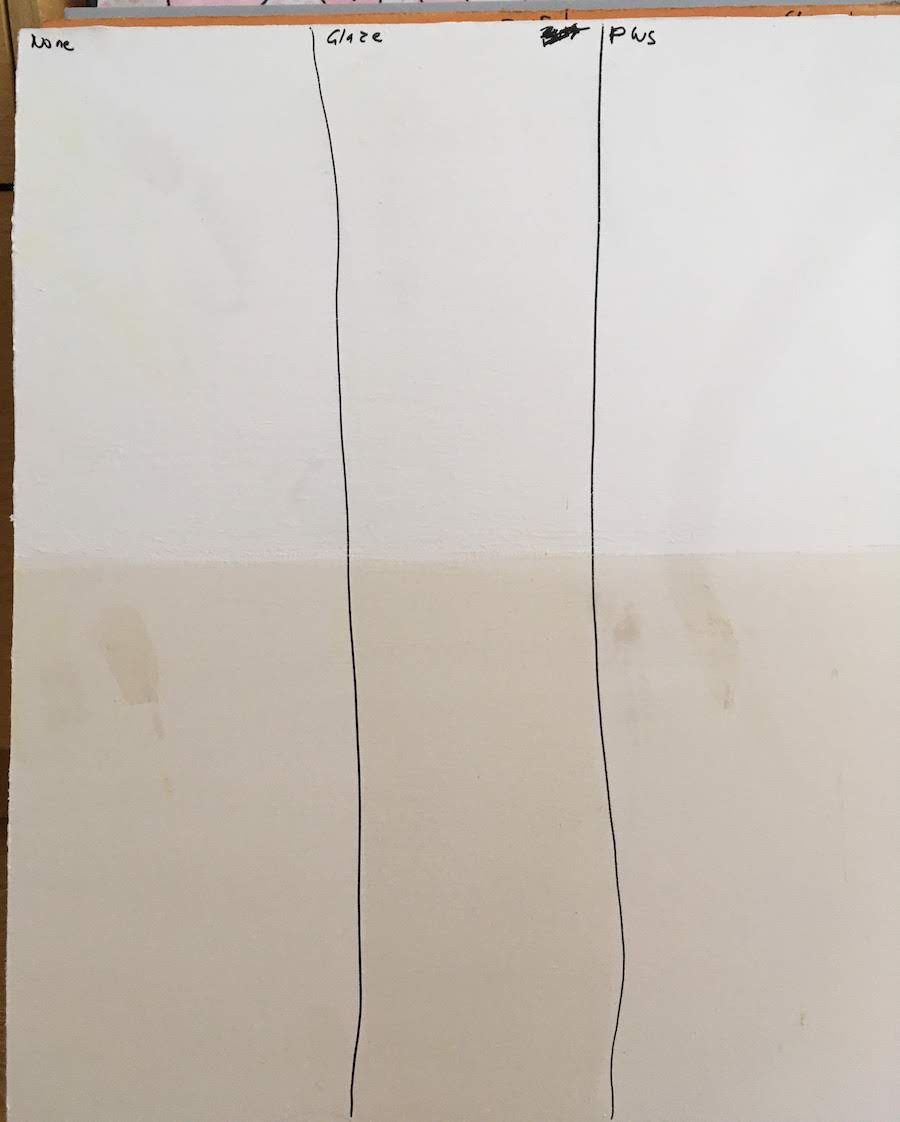This post covers sealants that you can (or should) use over Milk Paint, water-based acrylic paint, Chalk Paint, and clay paint to make them more durable to liquids, stains, and general wear.
Some sealants would change the look of the paint (the sheen level or even the color) and others will look invisible.
Different sealants would be used for interior versus exterior projects.
1. To Seal Milk Paint on the Interior

Depending on where you are applying the Milk Paint and how durable you need it to be, you can choose from a number of topcoats including:
Natural oils: hemp oil, walnut oil (with wax), and the most durable penetrating oil, tung oil can all be used to seal Milk Paint. The oils tint the color – they darken it making the Milk Paint look richer, less pastel, not matte and chalk-like, and they add a slight yellow tint which you would only be able to see on some whites. Make sure the oil is compatible with the paint color. (See picture below).
Tung oil has the strongest (natural) odor of the three. Hemp and walnut oil are both quite mild in odor.
Water-based synthetic coatings: water-based acrylic coatings like Milk Paint Finishing Cream, or AFM Acriglaze work well over Milk Paint.
I did not have good luck with polyurethane or other acrylic coatings that are intended for wood floor finishing over Milk Paint
Natural waxes: You can find a good selection at The Real Milk Company and MilkPaint.com.
Alcohol-based coating: Shellac does work over Milk Paint but it looked uneven when applied directly onto the Milk Paint. It worked better when applying a natural oil first, then shellac (see photo below, but make sure you put enough coats of milk paint on before the oil as the oil will bring out the imperfections!). This leaves the Milk Paint very durable! It would be a good combo on toys and I would consider it for cabinets as well.
2. To Seal Milk Paint on the Exterior

Tung oil is the best sealant for Milk Paint that I know of. Be sure to put on enough coats of Milk Paint before the oil. As you can see above, my one coat of Milk Paint looked fine when it was just the paint, but once I added the tung oil it was clear that the paint was not applied thick enough.
Note, don’t use the shellac on exterior applications, that is just for the interior.
The color is Federal Blue from Old Fashioned Milk Paint
Synthetic polyurethane sealants didn’t work well over Milk Paint in my trials.
3. To Seal Water-Based Acrylic (Latex) Paint on the Interior & Exterior
You don’t need a sealant on interior acrylic paint. If you used a paint that is too matte to hold up to what you need, you can go over with the same paint in a higher sheen. That will give it more durability and the ability to wipe it down easily.
AFM Polyureseal EXT is a clear low VOC polyurethane that can be applied over painted surfaces (usually this is used on the exterior).
You can also use other polyurethane or acrylic coatings over paint to make it more durable or to seal in a paint that is offgassing or toxic. See the post on remediating offgassing for more options.
4. To Seal Chalk Paint

I tried the Annie Sloan Wax which smelled like petroleum products to me and I did not tolerate it at my level of chemical sensitivity.
With Annie Sloan wax over Chalk Paint, it held up extremely well to mustard and mayo. Wax is actually the most durable coating over Chalk Paint.
You don’t have to use this type of wax, you can use a wax from The Real Milk Paint Company that is made with safer solvents or no solvents.
If you are waxing Chalk Paint, this large wax brush can be used to apply it to the walls. Remove the excess with a cloth.
I also tried the BioShield Glaze and that helped it hold up perfectly to mustard and mayo as well.
AFM Penetrating Waterstop did not help it hold up to mustard or mayo even though I had great results using this over clay plaster.
Acriglaze does not work over chalk paint either.
5. To Seal Clay Paint

Over BioShield Clay paint you can use Wall Glaze or AFM Penetrating Waterstop to add more water resistance and cleanability – I tested both of these. They recommend the wall glaze for areas like the kitchen and hallway.
The ingredients of the wall glaze are cellulose, alcohol ester, silica, carnauba wax, clay, water, and preservative.
BioShield Solvent-Free Paint worked the best with AFM Penetrating Waterstop as the sealant. It helped it hold up with no staining from either mustard or mayo and the clay paint retained the same color and sheen.
Wall Glaze also worked well on BioShield Solvent-Free Wall Paint but there is an ever so slight mustard stain.
Their basic Clay Paint held up best with their Wall Glaze. With an ever-so-slight stain from my tests that cannot really be seen from a few feet away.
AFM Penetrating Waterstop did not help the basic Clay Paint hold up well.
Acriglaze works perfectly over clay paint as well, but I didn’t test this one.

Corinne Segura holds certificates in Building Biology, Healthier Materials and Sustainable Buildings, and more. She has 10 years of experience helping others create healthy homes.
If you would like to support the research behind this blog you can make a donation via Kofi!

Bonnie Leigh
Hi Corinne,
I painted a bathtub with art/ craft indoor outdoor paint. I had painted my mailbox with these many years ago and it has held up perfectly in all kinds if weather.
I let the tub “cure” for a week then took a shower. some paint lifted off while wet. is there something nontoxic I can seal it with? I am highly sensitive to chemicals.
thank you!
Corinne Segura, Building Biologist
that’s not the right kind of paint for a ceramic or plastic bathtub. need a better paint to start.
Rita Stahl
Thank you, Corinne, for such a detailed and informing site! I really need a new kitchen but that is never going to happen in this lifetime on this planet 🙂 but with the info you’ve given, I’m pretty sure I can do a few things myself and will be happy with it however it turns out!
Corinne Segura
that’s good!
Alex
Hello! We are downsizing into a small trailer, which has great real wood cabinets in the kitchen. I plan to clean and sand them, and then use milk paint from the Milk Paint Co. I am going to seal with tung oil, and I understand it will change the color quite a bit so I will do some testing first. I’m wondering though, once it’s all done:
1. Will the cabinets be easy to wipe down and clean with the tung oil sealant?
2. And will it need to be reapplied every so often?
Thank you for your help!
Corinne
1) yes once cured 2) check with the company
Aaron Hunter
What is safe to use on new construction all wood cabinets for a sealant?
Nila Helmig
I’m looking for a stain on my wooden kitchen cabinets. The cabinets now have a coating on them that seems to get tacky when cleaning. The former tenants didn’t wash their hands frequently, and at first I thought it was their residue I was trying to remove. Now I’m thinking harsh chemicals melted the satin finish. What is your recommendation for these?
Corinne
you should have a woodworker look at that in person, you might have to remove the stain or paint that is there first (most likely)
Alexia
Hi my dad wanted to be helpful and he wanted to cover the scratches on a bureau that I was going to take to my house from theirs so he painted it, he promised he would use water based paint because I’m so chemical averse. Meanwhile I just went there and saw the can, it was definitely not non toxic. It’s behr chalk paint I just saw how toxic it is and cancer warnings on the label. What do I do now? Do the VOC’s go away? What can I do to make it safe? Should I forget about bringing it to my house?
Corinne
See the post on chalk paint
Tammy
I painted mason jars with a water based paint and put glitter on them is there a sealant I can use?
Corinne
Yep the one on the list for water-based acrylic.
Charlotte
Hi Corrine, What would you recommend for sealing a painted wooden bath panel and making it waterproof? (It’s painted with an alleged voc free furniture paint by “little knights”). Would really appreciate any tips (although I’m UK based). Thank you, Charlotte
Erin
I can’t believe I’m just NOW discovering this website! Thank you for all this information! We have a reclaimed wood wall with barn wood panels that are 100+ years old. I just ordered a lead-testing kit, but even if it’s lead free, I’m sure there are other harmful chemicals seeping out of the wood (I also have an old desk made out of old wood as well). We want to make our Toddler Playroom in the same area as the wall and desk, so I’d like to seal them up safely, but also keep that matte-weathered (non-shiney) look. What would you recommend? TY!!
Corinne
It depends on what is on them now, it’s not clear what kind of coating they have on them now.
Erin
There doesn’t seem to be any coating on the barn wood, just the old paint from 100+ years ago, which is also very weathered. What should I paint over it to seal it all up (clear)? The desk looks like it has a wax seal on it. Thank you!
Brittany
Do you have a paint and sealer recommendation for over mosaic tile? We don’t want to remove our mosaic backslash (due to the amount of lead and having a toddler in the house). I see all these videos of just painting over them and thought that would be safer.
Corinne
I like Chalk Paint for over tile. You can also check out Rustoleum HOME which is 38g/l VOC. Another way to do it is to use shellac as a transitional primer.